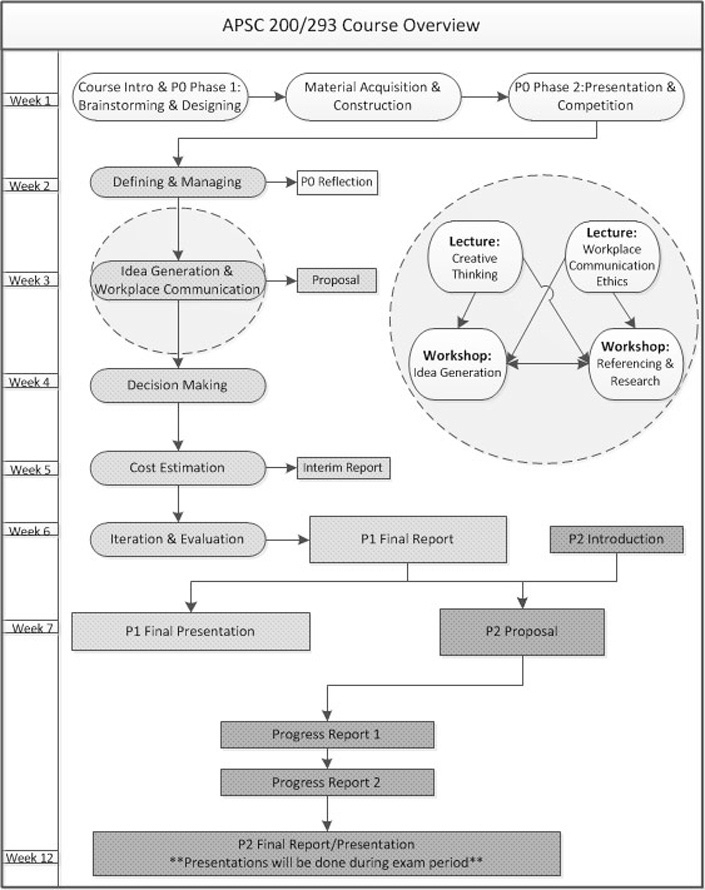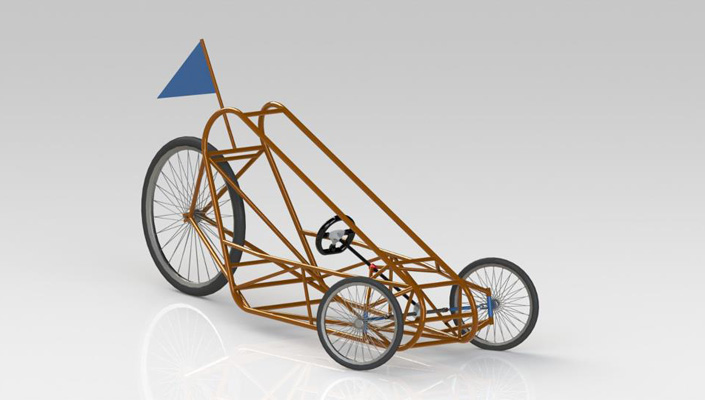APSC-200/293 Engineering Design and Practice II
The second year component of the design spine is implemented as the faculty-wide, one semester design course of APSC-200, integrated with the communications course APSC-293. The splitting of the EDPS II into APSC-200 and APSC-293 was made primarily for administrative reasons, as it provides a way of tracking students separately on their competencies for both communications and design. The coordinator is the same for both of these courses.
APSC-200/293 is a project-based course designed to be delivered in two parts over a 12-week semester. Common instruction is provided to all students in the first 6 weeks, and includes problem scoping, creativity, idea generation, engineering ethics, and decision making incorporating technical, economic, societal, and environmental factors, safety, engineering codes and regulations. Following an introductory project in the first week (P0), instruction in the next 5 weeks is paralleled by an open-ended non discipline-specific project (P1). The final 6 weeks of the course centers around a more advanced design project delivered by each discipline (P2). The communication course includes a small number of integrated lectures, online modules, and working tutorials practicing communication in the engineering context of deliverables in the design course.
A visual description of the course is shown below.

Week 1 – P0 project: In this introductory week, students work in groups to complete a simple design-and-build task using recycled/reused materials. The intent is to encourage creativity and team-building given minimal structure or design instruction, and also to stimulate interest in the design process and encourage students to enjoy and reflect on the experience. The task in 2011-2012 was to design a device for propelling a package towards a target, in 2012-2013 to design a device for launching a glider through a target hoop and landing in another, in 2013-14 to build a mousetrap car to achieve both distance and accuracy, and in 2014-15 to design a device for launching a street hockey puck towards others on a curling “sheet”. The P0 exercise is structured in two phases, one in each workshop session:
Phase 1: Conceive and Design: Following an introductory lecture, student groups develop an idea for subsequent testing. At the end of the workshop, they submit the design description, materials list, and concept sketches.
Phase 2: Implement and Operate: Students gather recycled/reused materials on their own time, then build and test their device in the first hour of the workshop. In the second hour, all devices are demonstrated.
Weeks 2-6 – P1 project and supporting instruction/activities: Instruction in design process with integrated professional practice and communication skills is applied in the context of an open-ended team-based engineering design experience. The project is intended to be virtual, although students are not discouraged from building all or part of a prototype. After reflection on their P0 project, the same student groups select a P1 project topic from among the options given. The theme in Fall 2011 was “Humanitarian Engineering”, where teams chose a country/region. In Fall 2011 the theme was “Humanitarian Engineering”, with teams choosing a country/region of implementation for context, based on researching needs, and also choosing a topic from the following:
- Energy generation and storage
- Water supply and purification
- Sustainable energy cooker
Themes in other years have included “Engineering Design for Improved Quality of Life in the Canadian North”, “Engineering Design for Climate Change Resiliency”, and “Engineering Design for H2O in a Canadian Climate”.
Modular lectures and active workshop exercises are delivered to coincide with the stages of the design project. APSC 200 topics include design process, idea generation and creativity, project management, integrating safety, decision making tools (pros/cons table, weighted evaluation matrix), value judgment (triple bottom line), cost estimation, and design assessment and iteration. Project deliverables are a design proposal, interim and final reports, and an oral presentation. APSC 293 communication workshops begin with a general lecture outlining the writing process, then throughout the project the topics support the various reporting aspects, including business communications and information research in a just-in-time fashion.
Weeks 7-12 – P2 project: Students tackle a discipline specific design topic proposed by their department and approved by the CRC to effectively illustrate the application of the design principles outlined in the first 6 weeks. No formal instruction is planned for this portion of the course, although some departments provide supporting technical instruction relevant to the project. Students are expected to follow the design, project management, and communication processes learned in the first 6 weeks and emphasized in P1. Although the course coordinator oversees this final project, the departmental coordinators are responsible for the specific content and structure.
Past project design topics from 2011 include a cell phone charger using recreational activities for energy supply, an improved mine ventilation system, and response to a chemical spill. The project on responses to chemical spills provides a great example of integrating design process, professional practice, and communication. The project challenge was to manage and remediate a spill of 1000 litres of trichloroethylene on a busy street in the heart of the university campus. Student teams designed solutions to remediate the spill while also managing pedestrian and road traffic and ensuring the safety of bystanders and cleanup workers. This required an understanding of all relevant laws, codes and standards, communication with external bodies, such as the city’s emergency response personnel and provincial oversight organizations such as Ministry of the Environment, familiarization and implementation of safe practices required for the site, and the technical requirements to capture, remove, and remediate the contaminated material.
The second half of the APSC-200 course retains the same timetabling, with departmental instructors working with disciplinary groups of students towards learning objectives common across the faculty. Departmental instructors determine if and how the lectures and workshop slots are used based on the needs of their particular project assignment. Typically one lecture and one workshop per week retain scheduled activities and the second workshop is offered as unstructured project time, although there is substantial variation as the students are encouraged to manage their own projects.

